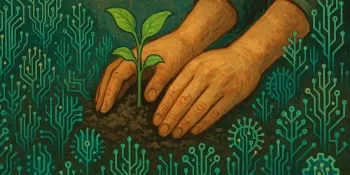Google Unveils A2A Protocol to Enhance AI Agent Interoperability
AI agents tackle complex, repetitive tasks like supply chain management and equipment procurement. As organizations adopt agents from various vendors and frameworks, these agents often become isolated, unable to collaborate effectively. Interoperability challenges persist, with agents sometimes offering contradictory recommendations. Standardizing AI workflows remains difficult, and integrating agents often requires middleware, introducing additional complexity and potential points of failure.
Google’s A2A Protocol Standardizes AI Agent Collaboration
At Cloud Next 2025, Google introduced its Agent2Agent (A2A) protocol, an open framework designed to streamline communication among diverse AI agents. A2A enables independent agents to interact and collaborate seamlessly, complementing Anthropic’s Model Context Protocol (MCP), which equips models with tools and context. While MCP links agents to resources, A2A fosters direct agent-to-agent connections. The protocol supports secure, real-time communication and task coordination across platforms and vendors.
In an A2A-enabled system, agents take on two roles: a client agent, which initiates tasks to achieve objectives or represent users, and a remote agent, which processes incoming requests. Roles can shift depending on the interaction, with an agent acting as a client in one scenario and a remote agent in another. A2A defines a standardized message format and workflow to guide these interactions.
Tasks form the core of A2A, each representing a unit of work or dialogue. The client agent sends a request, including instructions and a unique task ID, to the remote agent’s task endpoint. The remote agent then creates and processes the task.
Google’s initiative has garnered support from over 50 industry partners, including Intuit, Langchain, MongoDB, Atlassian, Box, Cohere, PayPal, Salesforce, SAP, Workday, ServiceNow, and UKG. Leading service providers such as Capgemini, Cognizant, Accenture, BCG, Deloitte, HCLTech, McKinsey, PwC, TCS, Infosys, KPMG, and Wipro also contribute to the effort.
HyperCycle’s Alignment with A2A Principles
HyperCycle’s Node Factory framework enables the deployment of multiple agents, overcoming existing barriers and empowering developers to build reliable, collaborative systems. This decentralized platform advances the vision of an “AI internet” by leveraging self-sustaining nodes and an innovative licensing model to support large-scale AI deployments. The framework standardizes interactions, ensuring agents from different developers operate cohesively, regardless of their origin.
HyperCycle’s peer-to-peer network connects agents across ecosystems, eliminating silos and enabling seamless data sharing and coordination. Self-replicating nodes enhance scalability, reducing infrastructure demands and balancing computational loads.
Each Node Factory can replicate up to ten times, doubling its node count with each cycle. Users can operate Factories at ten different levels, with growth increasing capacity to meet rising AI service demands. One node might host a communication-focused agent, while another supports data analysis. Developers can create tailored multi-agent solutions, addressing scalability and isolation challenges.
Built on Toda/IP architecture, akin to TCP/IP, HyperCycle’s Node Factory network supports hundreds of thousands of nodes, allowing developers to integrate third-party agents. For example, incorporating a third-party analytics agent can enhance functionality and foster collaboration across the network.
Toufi Saliba, HyperCycle’s CEO, views Google’s A2A as a pivotal milestone for agent collaboration. In an X post, he noted that A2A enables HyperCycle’s nodes to connect with AI agents across Google Cloud, AWS, Microsoft, and beyond, amplifying the reach of the “AI internet.” Saliba’s remarks underscore A2A’s potential and its synergy with HyperCycle’s mission.
HyperCycle’s Layer 0++ Enhances Security and Speed
HyperCycle’s Layer 0++ blockchain infrastructure delivers robust security and high-speed performance, complementing A2A by providing a decentralized foundation for AI agent interactions. Operating on Toda/IP, Layer 0++ fragments network packets and distributes them across nodes for efficiency.
It also enhances other blockchains by bridging to platforms like Bitcoin, Ethereum, Avalanche, Cosmos, Cardano, Polygon, Algorand, and Polkadot, extending their functionality without competing.
Applications in DeFi, Swarm AI, and Beyond
HyperCycle holds promise for applications in decentralized finance (DeFi), swarm AI, media ratings, decentralized payments, and computational processing. Swarm AI enables collective problem-solving through agent collaboration, with HyperCycle facilitating lightweight agents for complex tasks.
In media networks, HyperCycle enhances ratings and rewards via micro-transactions. Its ability to support high-frequency, low-cost, on-chain trading opens new possibilities in DeFi.
For decentralized payments and computing, HyperCycle boosts transaction speed and reduces costs, streamlining blockchain operations.
Before Google’s A2A announcement, HyperCycle launched a joint initiative with YMCA in January 2025. The Hyper-Y AI app connects 64 million people across 12,000 YMCA locations in 120 countries, providing staff, members, and volunteers with access to a global information network.
A2A and HyperCycle Drive Collaborative AI Ecosystems
Google’s open-source A2A protocol, developed with community input, aims to foster collaboration for solving complex challenges. HyperCycle’s innovations align with this vision, connecting AI agents to a global network of specialized capabilities. By standardizing agent communication across vendors and platforms, A2A and HyperCycle enable modular, scalable, and secure multi-agent systems.
Together, A2A and HyperCycle pave the way for a new era of AI interoperability, unlocking the potential for more dynamic and powerful agent-driven systems.
Related article
 ByteDance Unveils Seed-Thinking-v1.5 AI Model to Boost Reasoning Capabilities
The race for advanced reasoning AI began with OpenAI’s o1 model in September 2024, gaining momentum with DeepSeek’s R1 launch in January 2025.Major AI developers are now competing to create faster, mo
ByteDance Unveils Seed-Thinking-v1.5 AI Model to Boost Reasoning Capabilities
The race for advanced reasoning AI began with OpenAI’s o1 model in September 2024, gaining momentum with DeepSeek’s R1 launch in January 2025.Major AI developers are now competing to create faster, mo
 Qodo Partners with Google Cloud to Offer Free AI Code Review Tools for Developers
Qodo, an Israel-based AI coding startup focused on code quality, has launched a partnership with Google Cloud to enhance AI-generated software integrity.As businesses increasingly depend on AI for cod
Qodo Partners with Google Cloud to Offer Free AI Code Review Tools for Developers
Qodo, an Israel-based AI coding startup focused on code quality, has launched a partnership with Google Cloud to enhance AI-generated software integrity.As businesses increasingly depend on AI for cod
 Salesforce Unveils AI Digital Teammates in Slack to Rival Microsoft Copilot
Salesforce launched a new workplace AI strategy, introducing specialized “digital teammates” integrated into Slack conversations, the company revealed on Monday.The new tool, Agentforce in Slack, enab
Comments (0)
0/200
Salesforce Unveils AI Digital Teammates in Slack to Rival Microsoft Copilot
Salesforce launched a new workplace AI strategy, introducing specialized “digital teammates” integrated into Slack conversations, the company revealed on Monday.The new tool, Agentforce in Slack, enab
Comments (0)
0/200
AI agents tackle complex, repetitive tasks like supply chain management and equipment procurement. As organizations adopt agents from various vendors and frameworks, these agents often become isolated, unable to collaborate effectively. Interoperability challenges persist, with agents sometimes offering contradictory recommendations. Standardizing AI workflows remains difficult, and integrating agents often requires middleware, introducing additional complexity and potential points of failure.
Google’s A2A Protocol Standardizes AI Agent Collaboration
At Cloud Next 2025, Google introduced its Agent2Agent (A2A) protocol, an open framework designed to streamline communication among diverse AI agents. A2A enables independent agents to interact and collaborate seamlessly, complementing Anthropic’s Model Context Protocol (MCP), which equips models with tools and context. While MCP links agents to resources, A2A fosters direct agent-to-agent connections. The protocol supports secure, real-time communication and task coordination across platforms and vendors.
In an A2A-enabled system, agents take on two roles: a client agent, which initiates tasks to achieve objectives or represent users, and a remote agent, which processes incoming requests. Roles can shift depending on the interaction, with an agent acting as a client in one scenario and a remote agent in another. A2A defines a standardized message format and workflow to guide these interactions.
Tasks form the core of A2A, each representing a unit of work or dialogue. The client agent sends a request, including instructions and a unique task ID, to the remote agent’s task endpoint. The remote agent then creates and processes the task.
Google’s initiative has garnered support from over 50 industry partners, including Intuit, Langchain, MongoDB, Atlassian, Box, Cohere, PayPal, Salesforce, SAP, Workday, ServiceNow, and UKG. Leading service providers such as Capgemini, Cognizant, Accenture, BCG, Deloitte, HCLTech, McKinsey, PwC, TCS, Infosys, KPMG, and Wipro also contribute to the effort.
HyperCycle’s Alignment with A2A Principles
HyperCycle’s Node Factory framework enables the deployment of multiple agents, overcoming existing barriers and empowering developers to build reliable, collaborative systems. This decentralized platform advances the vision of an “AI internet” by leveraging self-sustaining nodes and an innovative licensing model to support large-scale AI deployments. The framework standardizes interactions, ensuring agents from different developers operate cohesively, regardless of their origin.
HyperCycle’s peer-to-peer network connects agents across ecosystems, eliminating silos and enabling seamless data sharing and coordination. Self-replicating nodes enhance scalability, reducing infrastructure demands and balancing computational loads.
Each Node Factory can replicate up to ten times, doubling its node count with each cycle. Users can operate Factories at ten different levels, with growth increasing capacity to meet rising AI service demands. One node might host a communication-focused agent, while another supports data analysis. Developers can create tailored multi-agent solutions, addressing scalability and isolation challenges.
Built on Toda/IP architecture, akin to TCP/IP, HyperCycle’s Node Factory network supports hundreds of thousands of nodes, allowing developers to integrate third-party agents. For example, incorporating a third-party analytics agent can enhance functionality and foster collaboration across the network.
Toufi Saliba, HyperCycle’s CEO, views Google’s A2A as a pivotal milestone for agent collaboration. In an X post, he noted that A2A enables HyperCycle’s nodes to connect with AI agents across Google Cloud, AWS, Microsoft, and beyond, amplifying the reach of the “AI internet.” Saliba’s remarks underscore A2A’s potential and its synergy with HyperCycle’s mission.
HyperCycle’s Layer 0++ Enhances Security and Speed
HyperCycle’s Layer 0++ blockchain infrastructure delivers robust security and high-speed performance, complementing A2A by providing a decentralized foundation for AI agent interactions. Operating on Toda/IP, Layer 0++ fragments network packets and distributes them across nodes for efficiency.
It also enhances other blockchains by bridging to platforms like Bitcoin, Ethereum, Avalanche, Cosmos, Cardano, Polygon, Algorand, and Polkadot, extending their functionality without competing.
Applications in DeFi, Swarm AI, and Beyond
HyperCycle holds promise for applications in decentralized finance (DeFi), swarm AI, media ratings, decentralized payments, and computational processing. Swarm AI enables collective problem-solving through agent collaboration, with HyperCycle facilitating lightweight agents for complex tasks.
In media networks, HyperCycle enhances ratings and rewards via micro-transactions. Its ability to support high-frequency, low-cost, on-chain trading opens new possibilities in DeFi.
For decentralized payments and computing, HyperCycle boosts transaction speed and reduces costs, streamlining blockchain operations.
Before Google’s A2A announcement, HyperCycle launched a joint initiative with YMCA in January 2025. The Hyper-Y AI app connects 64 million people across 12,000 YMCA locations in 120 countries, providing staff, members, and volunteers with access to a global information network.
A2A and HyperCycle Drive Collaborative AI Ecosystems
Google’s open-source A2A protocol, developed with community input, aims to foster collaboration for solving complex challenges. HyperCycle’s innovations align with this vision, connecting AI agents to a global network of specialized capabilities. By standardizing agent communication across vendors and platforms, A2A and HyperCycle enable modular, scalable, and secure multi-agent systems.
Together, A2A and HyperCycle pave the way for a new era of AI interoperability, unlocking the potential for more dynamic and powerful agent-driven systems.
 ByteDance Unveils Seed-Thinking-v1.5 AI Model to Boost Reasoning Capabilities
The race for advanced reasoning AI began with OpenAI’s o1 model in September 2024, gaining momentum with DeepSeek’s R1 launch in January 2025.Major AI developers are now competing to create faster, mo
ByteDance Unveils Seed-Thinking-v1.5 AI Model to Boost Reasoning Capabilities
The race for advanced reasoning AI began with OpenAI’s o1 model in September 2024, gaining momentum with DeepSeek’s R1 launch in January 2025.Major AI developers are now competing to create faster, mo
 Qodo Partners with Google Cloud to Offer Free AI Code Review Tools for Developers
Qodo, an Israel-based AI coding startup focused on code quality, has launched a partnership with Google Cloud to enhance AI-generated software integrity.As businesses increasingly depend on AI for cod
Qodo Partners with Google Cloud to Offer Free AI Code Review Tools for Developers
Qodo, an Israel-based AI coding startup focused on code quality, has launched a partnership with Google Cloud to enhance AI-generated software integrity.As businesses increasingly depend on AI for cod
 Salesforce Unveils AI Digital Teammates in Slack to Rival Microsoft Copilot
Salesforce launched a new workplace AI strategy, introducing specialized “digital teammates” integrated into Slack conversations, the company revealed on Monday.The new tool, Agentforce in Slack, enab
Salesforce Unveils AI Digital Teammates in Slack to Rival Microsoft Copilot
Salesforce launched a new workplace AI strategy, introducing specialized “digital teammates” integrated into Slack conversations, the company revealed on Monday.The new tool, Agentforce in Slack, enab





























